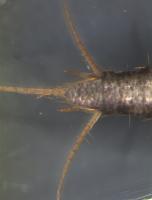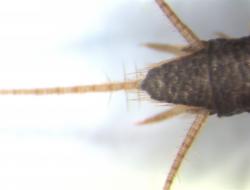Adult
Size
7 to 12 mm long.
Aspect
Wingless insects. Fusiform (spindle-shaped) body, wider at the front and getting narrower toward the rear end.
Antennae are the same length as the body.
Abdomen ending in 3 cerci half the body-length and of unequal length, the middle one being the longest.
Scales covering the whole body, giving them their characteristic silvery colour; the scales can sometimes peel off to enable the insects to free themselves from a spider’s web or from a predator’s grasp.
Colour
Entirely silvery metallic grey.


 Petit poisson d’argent Lépisme Lépisme argenté Lépisme du sucre.
Petit poisson d’argent Lépisme Lépisme argenté Lépisme du sucre.  Silverfish wood fish paper moth fish moth silver witch.
Silverfish wood fish paper moth fish moth silver witch.  El pececillo de plata
El pececillo de plata  Silberfischchen
Silberfischchen 



